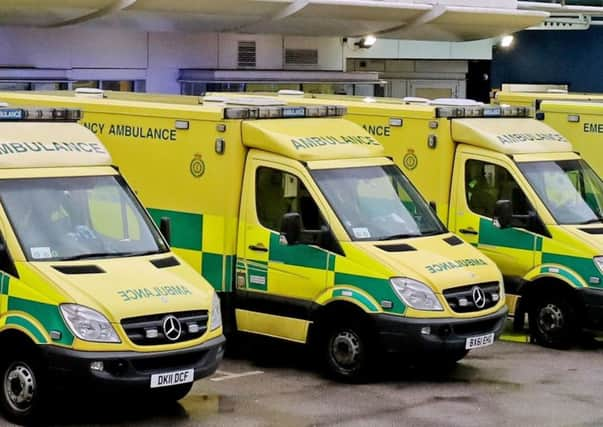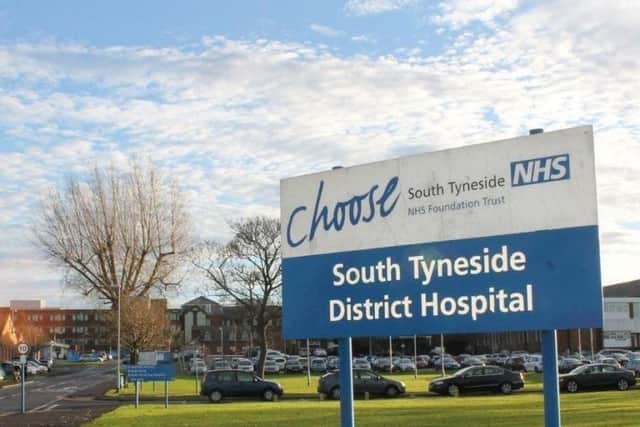Delays see hospital patients wait more than an hour in ambulances outside South Tyneside District Hospital


Ambulances took 2,766 patients to the South Tyneside District Hospital emergency department between December 3 and February 3, according to NHS Digital data.
Of those, 219 waited between 30 and 60 minutes before A&E staff were able to take over from paramedics, and 46 arrivals waited for more than an hour.


Advertisement
Hide AdAdvertisement
Hide AdDespite the NHS saying a delay of just 15 minutes is a potential threat to life, 12 patients waited up to an hour on the day when the problem was at its most severe.
The overall number of delays at the South Tyneside Trust has soared since 2017-18.
Over the same period last winter, 158 patients waited in ambulances for 30 minutes or more, 68% fewer than this year.
South Tyneside NHS Trust bosses have apologised for the delays which came during a specifically busy period with high numbers of ambulance arrivals.


Advertisement
Hide AdAdvertisement
Hide AdUnison said delays risk the safety of patients and are “a terrible waste” of ambulance crews’ skills.
Colm Porter, Unison’s national ambulance officer, said: “Handover delays are a stark illustration of the extreme pressure on the NHS caused by years of chronic underfunding.
“Not only are patients put at risk with lengthy waits to get into A&E, but there are also fewer ambulances available to respond to emergencies.
“Ambulance staff are stuck in hospitals when they should be out responding to life-or-death 999 calls. This is a terrible waste of their skills and the stress it causes can soon takes its toll on their health.”
Advertisement
Hide AdAdvertisement
Hide AdThe Society for Acute Medicine said emergency staff are only too aware that waiting in the back of an ambulance is inherently less safe for patients.
President Dr Nick Scriven said: “Staff will be forced to make horrible decisions about who gets the next space when one becomes free, fully aware that any mistakes could be catastrophic.”
NHS bosses have stressed that A&Es should always accept handover of patients within 15 minutes of arrival by ambulance.
An NHS spokesperson said: “Thanks to the hard work of ambulance and hospitals more people have benefited from a timely handover this year, despite a significant increase in people requiring care.
Advertisement
Hide AdAdvertisement
Hide Ad“We remain committed to further reducing delayed handovers, so that ambulance crews are able to get back out on the road and providing care to patients sooner.”
Across England, nearly 100,000 people waited for 30 minutes or more between December and February – one in 10 arrivals.
Dr Sean Fenwick, director of operations at South Tyneside and City Hospitals Sunderland NHS Foundation Trust, said: “This year we experienced one of our busiest festive periods on record for both South Tyneside and Sunderland, with more ambulances arriving at our hospitals than ever before.
“In the three weeks over Christmas and New Year, we saw a 16% increase in emergency ambulance arrivals in Sunderland with over 100 patients arriving by ambulance every single day - more than the region’s two major trauma centres.
Advertisement
Hide AdAdvertisement
Hide Ad“In South Tyneside, we also saw a 5% increase compared to the same period last year and this inevitably puts additional pressure in the system.
“We apologise to any patients who may have experienced a delay when arriving at our emergency departments this winter.
“Our staff have done a truly exemplary job in making sure all patients receive prompt clinical triage and that they are kept safe and well cared for during such times of peak demand.
“We also appreciate how frustrating it is for ambulance crews when there are delays in handing over patients at hospital and our teams work very closely together to ensure that patients are seen and assessed as quickly as possible.
Advertisement
Hide AdAdvertisement
Hide Ad“It is crucial, however, that we look at the underlying reasons why people are coming into hospital and think about how we can reduce pressures overall on our emergency services.
“Not every patient that arrives by emergency ambulance needs urgent life-saving treatment and at times of extreme pressure our teams must prioritise those people with the most urgent clinical needs – unfortunately in some circumstances this does mean people with less urgent problems may have to wait longer.”
Douglas McDougall, strategic head of operations at the North East Ambulance Service, said: “Ambulance handover delays are a reflection of the pressure felt across the whole NHS system, especially during times of peak demand and surges in activity.
“We operate a system on behalf of the region, which monitors hospital capacity and demand in real-time, to manage pressures in the system and divert patients to alternative care when necessary.
Advertisement
Hide AdAdvertisement
Hide Ad“This means we’re able to support our hospital colleagues when we can see an issue in any particular hospital.
“A delayed handover can mean that our crews end up queuing at hospital with their patients and tie up ambulance crews who are needed on the road to respond to other emergencies.
“During increased busy times, our staff can experience late meal breaks and late finishes, something that makes a real difference to our employee wellbeing.
“We continue to work with the acute trusts and our commissioners to minimise delays experienced by our patients and staff when handing over at North East hospitals.”